Thermodynamics Assignment: Ideal Gas, Carnot Cycle, Engine Comparison
VerifiedAdded on 2023/01/19
|6
|1065
|92
Homework Assignment
AI Summary
This assignment solution addresses three thermodynamics problems. The first problem derives the relationship between pressure and temperature during the adiabatic expansion of an ideal gas. The second problem focuses on the Carnot cycle, calculating efficiency and exploring relationships between heat transfer and work done. The third problem compares the Carnot engine to a four-stroke internal combustion engine, discussing energy losses and the challenges of achieving Carnot efficiency in practical engines. The solution includes calculations, explanations, and references to relevant scientific literature, providing a comprehensive analysis of thermodynamic principles and engine operation.
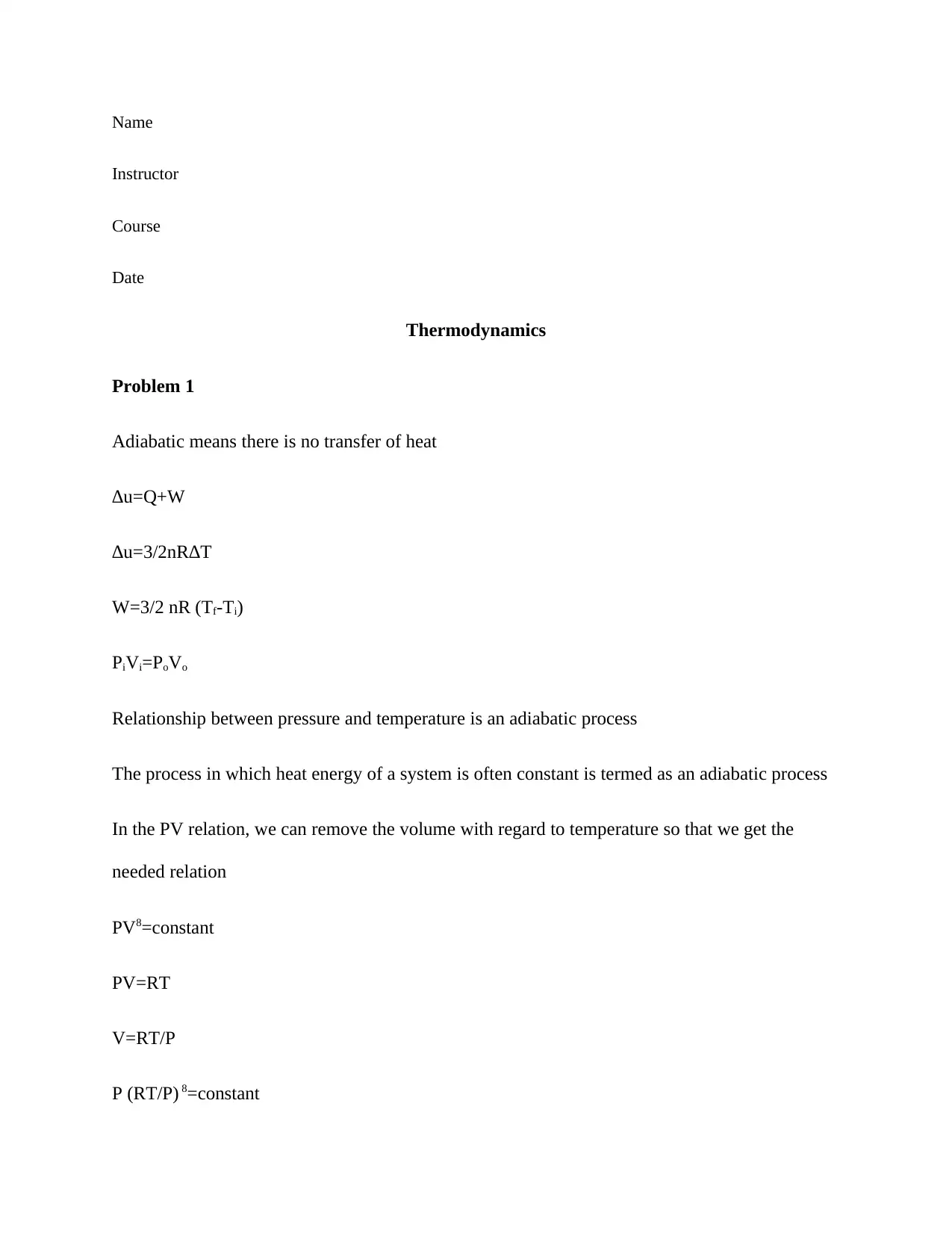
Name
Instructor
Course
Date
Thermodynamics
Problem 1
Adiabatic means there is no transfer of heat
∆u=Q+W
∆u=3/2nR∆T
W=3/2 nR (Tf-Ti)
PiVi=PoVo
Relationship between pressure and temperature is an adiabatic process
The process in which heat energy of a system is often constant is termed as an adiabatic process
In the PV relation, we can remove the volume with regard to temperature so that we get the
needed relation
PV8=constant
PV=RT
V=RT/P
P (RT/P) 8=constant
Instructor
Course
Date
Thermodynamics
Problem 1
Adiabatic means there is no transfer of heat
∆u=Q+W
∆u=3/2nR∆T
W=3/2 nR (Tf-Ti)
PiVi=PoVo
Relationship between pressure and temperature is an adiabatic process
The process in which heat energy of a system is often constant is termed as an adiabatic process
In the PV relation, we can remove the volume with regard to temperature so that we get the
needed relation
PV8=constant
PV=RT
V=RT/P
P (RT/P) 8=constant
Paraphrase This Document
Need a fresh take? Get an instant paraphrase of this document with our AI Paraphraser
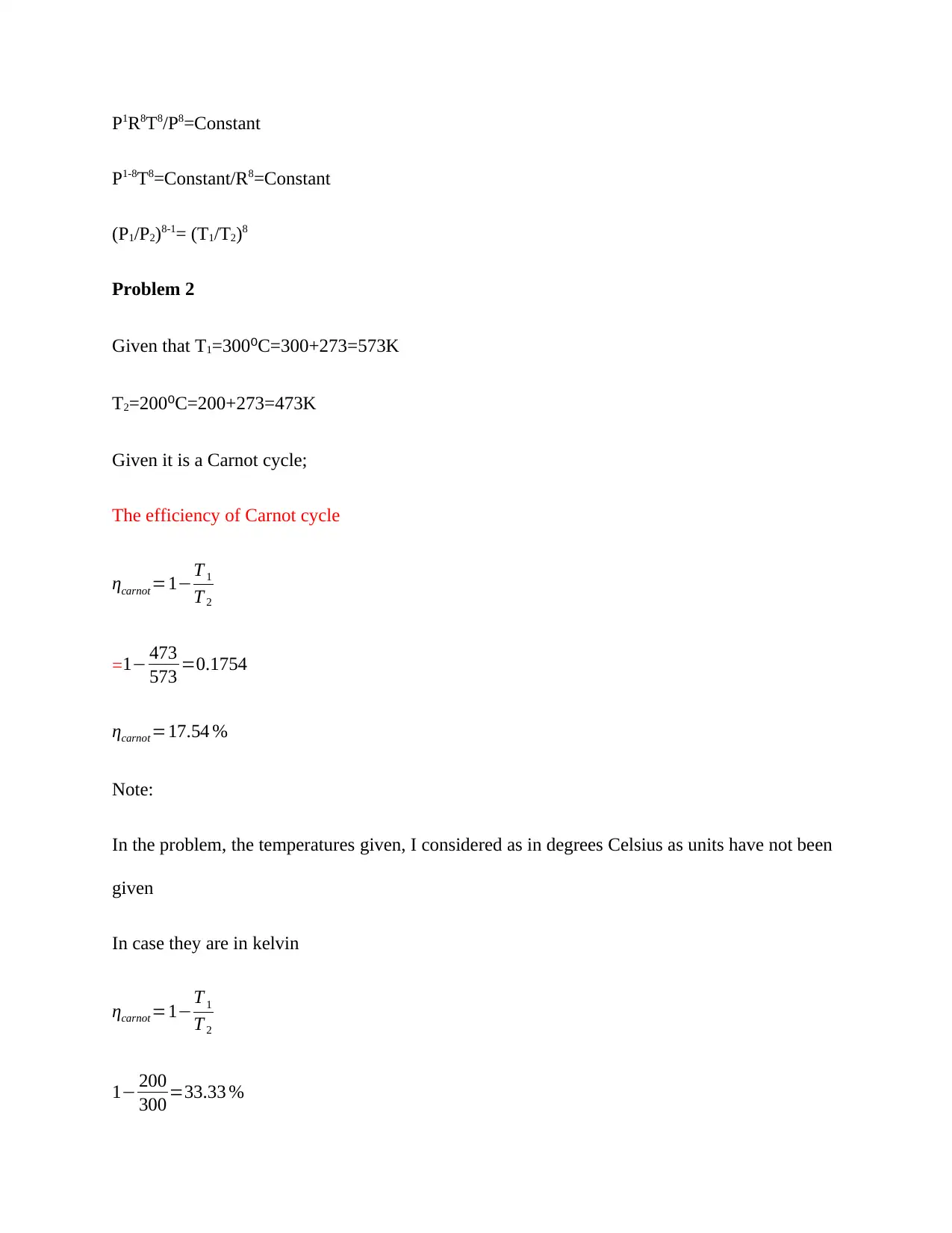
P1R8T8/P8=Constant
P1-8T8=Constant/R8=Constant
(P1/P2)8-1= (T1/T2)8
Problem 2
Given that T1=300⁰C=300+273=573K
T2=200⁰C=200+273=473K
Given it is a Carnot cycle;
The efficiency of Carnot cycle
ηcarnot =1−T 1
T 2
=1− 473
573 =0.1754
ηcarnot =17.54 %
Note:
In the problem, the temperatures given, I considered as in degrees Celsius as units have not been
given
In case they are in kelvin
ηcarnot =1−T 1
T 2
1− 200
300 =33.33 %
P1-8T8=Constant/R8=Constant
(P1/P2)8-1= (T1/T2)8
Problem 2
Given that T1=300⁰C=300+273=573K
T2=200⁰C=200+273=473K
Given it is a Carnot cycle;
The efficiency of Carnot cycle
ηcarnot =1−T 1
T 2
=1− 473
573 =0.1754
ηcarnot =17.54 %
Note:
In the problem, the temperatures given, I considered as in degrees Celsius as units have not been
given
In case they are in kelvin
ηcarnot =1−T 1
T 2
1− 200
300 =33.33 %
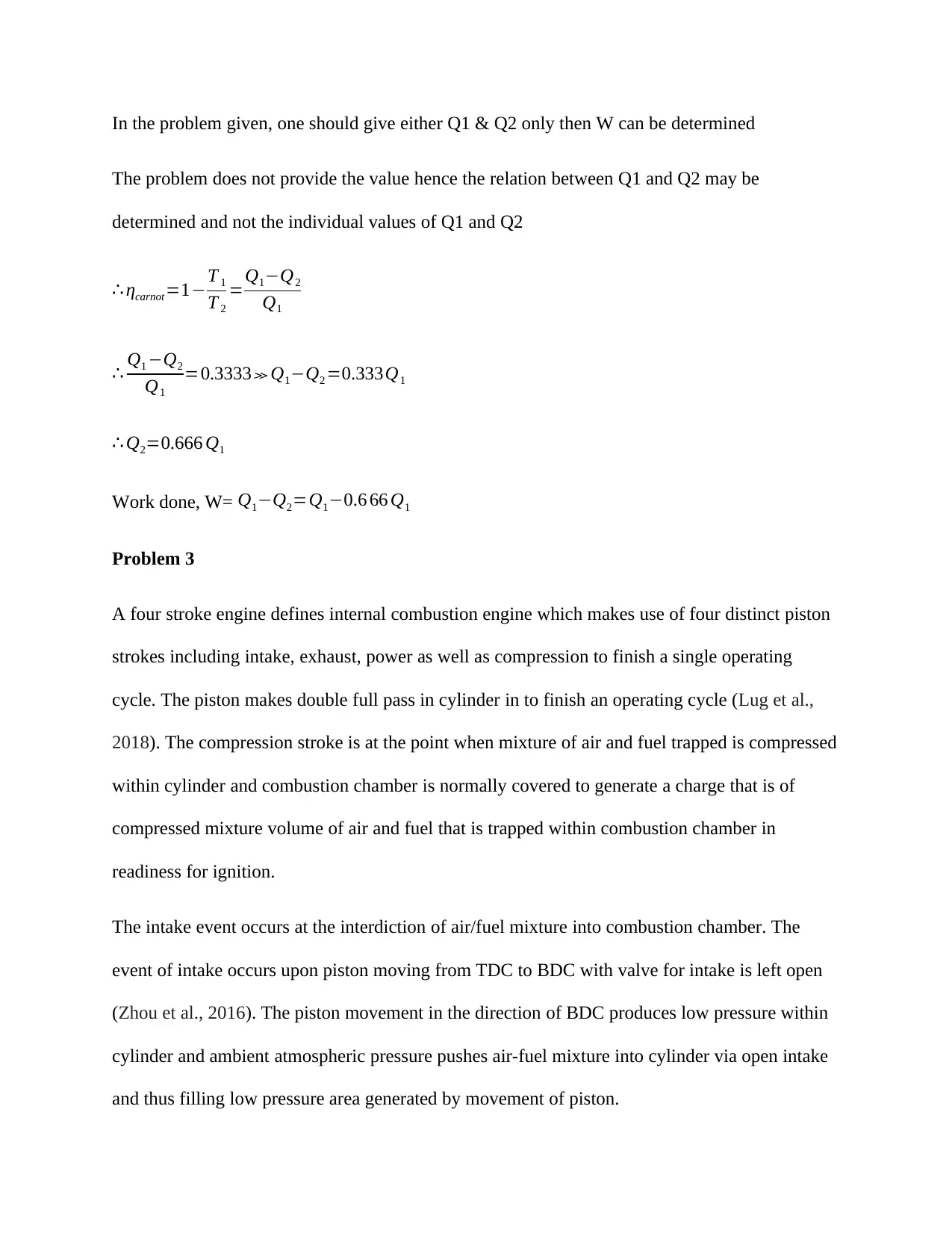
In the problem given, one should give either Q1 & Q2 only then W can be determined
The problem does not provide the value hence the relation between Q1 and Q2 may be
determined and not the individual values of Q1 and Q2
∴ ηcarnot =1−T 1
T 2
=Q1−Q2
Q1
∴ Q1 −Q2
Q1
=0.3333≫ Q1−Q2 =0.333Q1
∴ Q2=0.666 Q1
Work done, W= Q1−Q2=Q1−0.6 66 Q1
Problem 3
A four stroke engine defines internal combustion engine which makes use of four distinct piston
strokes including intake, exhaust, power as well as compression to finish a single operating
cycle. The piston makes double full pass in cylinder in to finish an operating cycle (Lug et al.,
2018). The compression stroke is at the point when mixture of air and fuel trapped is compressed
within cylinder and combustion chamber is normally covered to generate a charge that is of
compressed mixture volume of air and fuel that is trapped within combustion chamber in
readiness for ignition.
The intake event occurs at the interdiction of air/fuel mixture into combustion chamber. The
event of intake occurs upon piston moving from TDC to BDC with valve for intake is left open
(Zhou et al., 2016). The piston movement in the direction of BDC produces low pressure within
cylinder and ambient atmospheric pressure pushes air-fuel mixture into cylinder via open intake
and thus filling low pressure area generated by movement of piston.
The problem does not provide the value hence the relation between Q1 and Q2 may be
determined and not the individual values of Q1 and Q2
∴ ηcarnot =1−T 1
T 2
=Q1−Q2
Q1
∴ Q1 −Q2
Q1
=0.3333≫ Q1−Q2 =0.333Q1
∴ Q2=0.666 Q1
Work done, W= Q1−Q2=Q1−0.6 66 Q1
Problem 3
A four stroke engine defines internal combustion engine which makes use of four distinct piston
strokes including intake, exhaust, power as well as compression to finish a single operating
cycle. The piston makes double full pass in cylinder in to finish an operating cycle (Lug et al.,
2018). The compression stroke is at the point when mixture of air and fuel trapped is compressed
within cylinder and combustion chamber is normally covered to generate a charge that is of
compressed mixture volume of air and fuel that is trapped within combustion chamber in
readiness for ignition.
The intake event occurs at the interdiction of air/fuel mixture into combustion chamber. The
event of intake occurs upon piston moving from TDC to BDC with valve for intake is left open
(Zhou et al., 2016). The piston movement in the direction of BDC produces low pressure within
cylinder and ambient atmospheric pressure pushes air-fuel mixture into cylinder via open intake
and thus filling low pressure area generated by movement of piston.
⊘ This is a preview!⊘
Do you want full access?
Subscribe today to unlock all pages.

Trusted by 1+ million students worldwide

The ignition or combustion event takes place upon ignition of charge and quickly oxidized via a
chemical reaction releasing energy in the form of heat. Combustion defines rapid and oxidizing
chemical reaction when fuel comes together with oxygen present in space to produce heat
energy. A short but definite time for diversification of flame about combustion chamber makes
up a proper combustion.
The power stroke defines engine operation stroke where hot expanding gases push head of the
piston away from head of the cylinder (Zhou et al., 2016). The force of the piston and the
resultant motion are moved to via connecting rod to introduced torque to crankshaft in which
applied torque starts off rotation of crankshaft. The pressure on piston influenced the amount of
torque that is generated. Other factors that influence the amount of torque include the size of
piston as well as the engine throw. The two valves are closed during power stroke.
The exhaust stroke takes place when gases that have been spent are removed from combustion
tube and let into space. The exhaust stroke serves as last stroke and takes place in circumstance
when exhaust valve is kept open when intake valve remains closed. The gases are evacuated into
the atmosphere through the movement of piston (Ahmadi et al., 2016).
The rate of energy loss is higher is a four stroke internal combustion engine as compared to a
Carnot engine (Huleihil & Mahmoud 2018). The operation of Carnot engine is such that
movement and conversion of energy from one form to another takes place within a refined
system and change from one side of side to other.
The Carnot engine is a derivative of Carnot cycle which is an imaginary cycle of conversion of
energy from heat to mechanical energy where all four components of cycle can be reversed. Two
of four parts of cycle involve in the transfer of heat across the tiny (differential) temperature
chemical reaction releasing energy in the form of heat. Combustion defines rapid and oxidizing
chemical reaction when fuel comes together with oxygen present in space to produce heat
energy. A short but definite time for diversification of flame about combustion chamber makes
up a proper combustion.
The power stroke defines engine operation stroke where hot expanding gases push head of the
piston away from head of the cylinder (Zhou et al., 2016). The force of the piston and the
resultant motion are moved to via connecting rod to introduced torque to crankshaft in which
applied torque starts off rotation of crankshaft. The pressure on piston influenced the amount of
torque that is generated. Other factors that influence the amount of torque include the size of
piston as well as the engine throw. The two valves are closed during power stroke.
The exhaust stroke takes place when gases that have been spent are removed from combustion
tube and let into space. The exhaust stroke serves as last stroke and takes place in circumstance
when exhaust valve is kept open when intake valve remains closed. The gases are evacuated into
the atmosphere through the movement of piston (Ahmadi et al., 2016).
The rate of energy loss is higher is a four stroke internal combustion engine as compared to a
Carnot engine (Huleihil & Mahmoud 2018). The operation of Carnot engine is such that
movement and conversion of energy from one form to another takes place within a refined
system and change from one side of side to other.
The Carnot engine is a derivative of Carnot cycle which is an imaginary cycle of conversion of
energy from heat to mechanical energy where all four components of cycle can be reversed. Two
of four parts of cycle involve in the transfer of heat across the tiny (differential) temperature
Paraphrase This Document
Need a fresh take? Get an instant paraphrase of this document with our AI Paraphraser
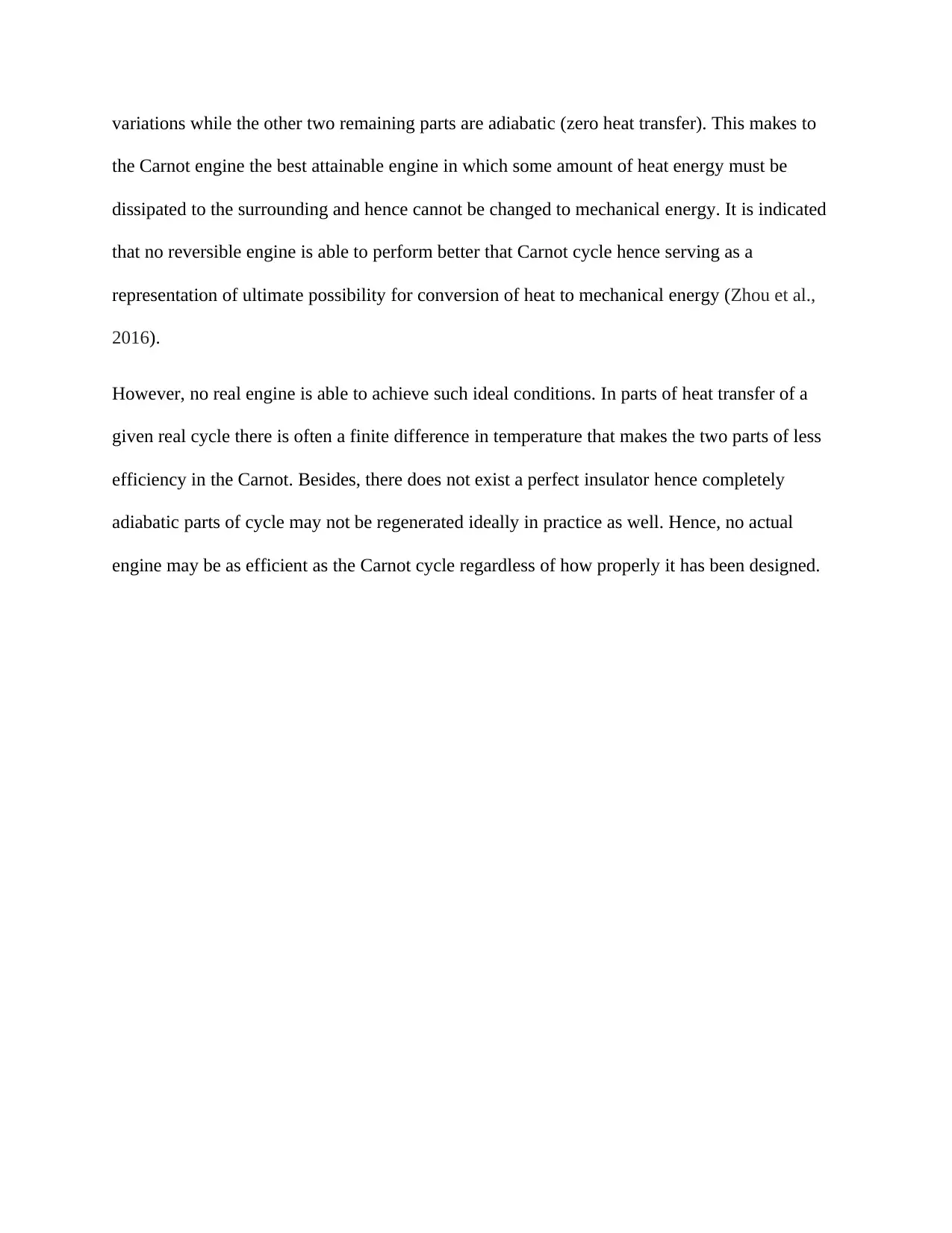
variations while the other two remaining parts are adiabatic (zero heat transfer). This makes to
the Carnot engine the best attainable engine in which some amount of heat energy must be
dissipated to the surrounding and hence cannot be changed to mechanical energy. It is indicated
that no reversible engine is able to perform better that Carnot cycle hence serving as a
representation of ultimate possibility for conversion of heat to mechanical energy (Zhou et al.,
2016).
However, no real engine is able to achieve such ideal conditions. In parts of heat transfer of a
given real cycle there is often a finite difference in temperature that makes the two parts of less
efficiency in the Carnot. Besides, there does not exist a perfect insulator hence completely
adiabatic parts of cycle may not be regenerated ideally in practice as well. Hence, no actual
engine may be as efficient as the Carnot cycle regardless of how properly it has been designed.
the Carnot engine the best attainable engine in which some amount of heat energy must be
dissipated to the surrounding and hence cannot be changed to mechanical energy. It is indicated
that no reversible engine is able to perform better that Carnot cycle hence serving as a
representation of ultimate possibility for conversion of heat to mechanical energy (Zhou et al.,
2016).
However, no real engine is able to achieve such ideal conditions. In parts of heat transfer of a
given real cycle there is often a finite difference in temperature that makes the two parts of less
efficiency in the Carnot. Besides, there does not exist a perfect insulator hence completely
adiabatic parts of cycle may not be regenerated ideally in practice as well. Hence, no actual
engine may be as efficient as the Carnot cycle regardless of how properly it has been designed.
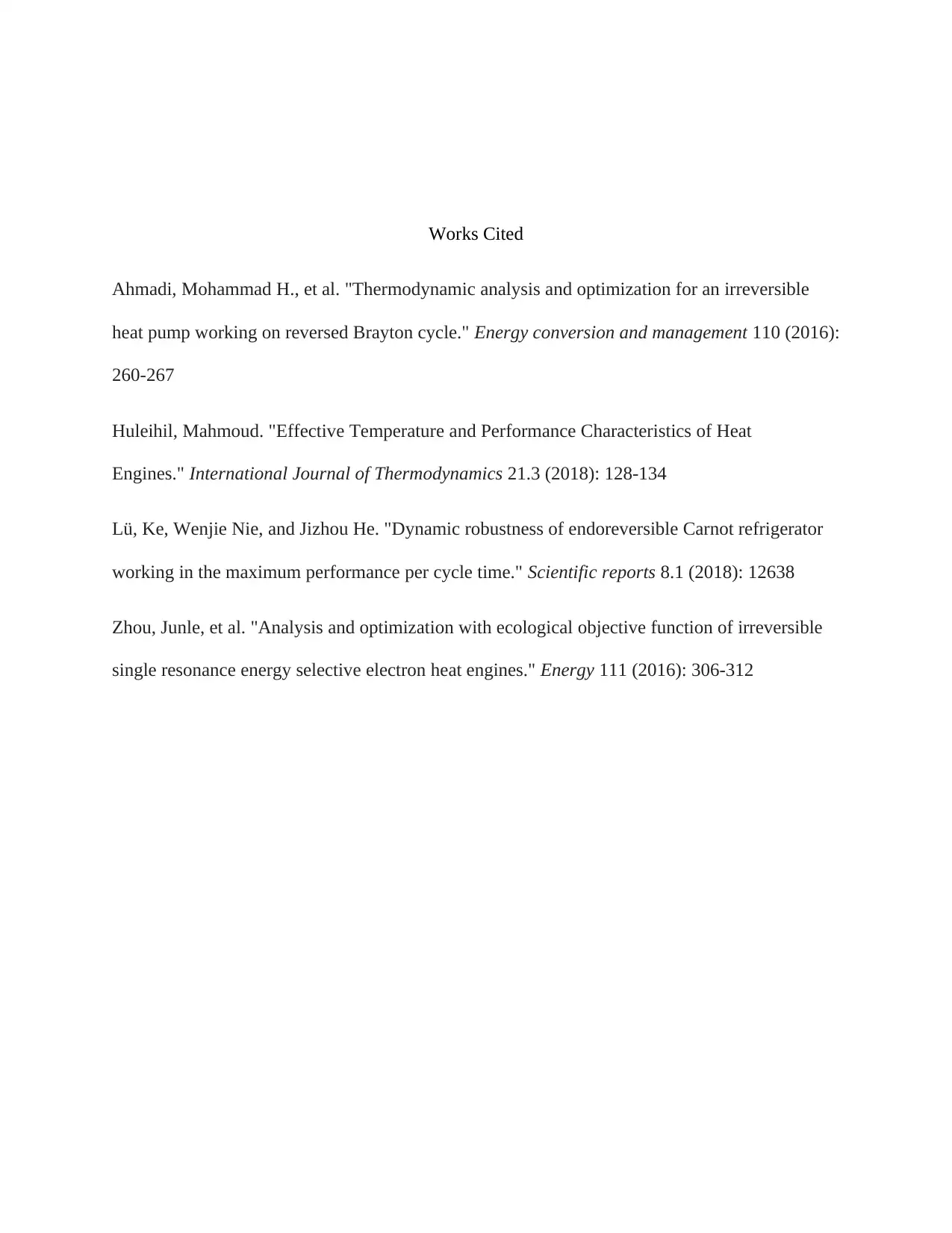
Works Cited
Ahmadi, Mohammad H., et al. "Thermodynamic analysis and optimization for an irreversible
heat pump working on reversed Brayton cycle." Energy conversion and management 110 (2016):
260-267
Huleihil, Mahmoud. "Effective Temperature and Performance Characteristics of Heat
Engines." International Journal of Thermodynamics 21.3 (2018): 128-134
Lü, Ke, Wenjie Nie, and Jizhou He. "Dynamic robustness of endoreversible Carnot refrigerator
working in the maximum performance per cycle time." Scientific reports 8.1 (2018): 12638
Zhou, Junle, et al. "Analysis and optimization with ecological objective function of irreversible
single resonance energy selective electron heat engines." Energy 111 (2016): 306-312
Ahmadi, Mohammad H., et al. "Thermodynamic analysis and optimization for an irreversible
heat pump working on reversed Brayton cycle." Energy conversion and management 110 (2016):
260-267
Huleihil, Mahmoud. "Effective Temperature and Performance Characteristics of Heat
Engines." International Journal of Thermodynamics 21.3 (2018): 128-134
Lü, Ke, Wenjie Nie, and Jizhou He. "Dynamic robustness of endoreversible Carnot refrigerator
working in the maximum performance per cycle time." Scientific reports 8.1 (2018): 12638
Zhou, Junle, et al. "Analysis and optimization with ecological objective function of irreversible
single resonance energy selective electron heat engines." Energy 111 (2016): 306-312
⊘ This is a preview!⊘
Do you want full access?
Subscribe today to unlock all pages.

Trusted by 1+ million students worldwide
1 out of 6
Your All-in-One AI-Powered Toolkit for Academic Success.
+13062052269
info@desklib.com
Available 24*7 on WhatsApp / Email
![[object Object]](/_next/static/media/star-bottom.7253800d.svg)
Unlock your academic potential
Copyright © 2020–2025 A2Z Services. All Rights Reserved. Developed and managed by ZUCOL.


